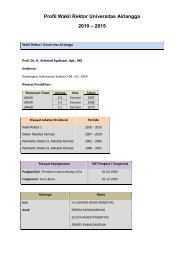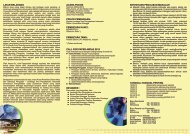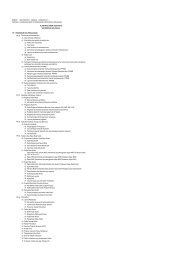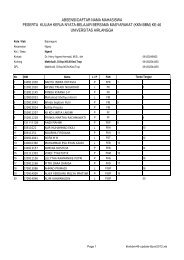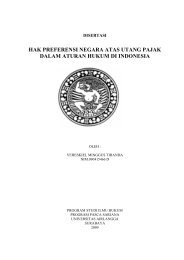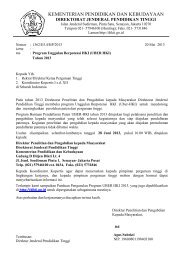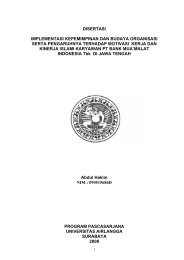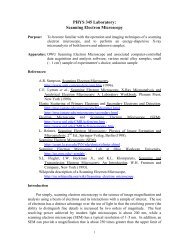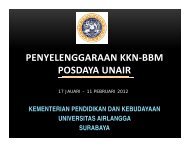View - UNAIR | E-Book Collection
View - UNAIR | E-Book Collection
View - UNAIR | E-Book Collection
Create successful ePaper yourself
Turn your PDF publications into a flip-book with our unique Google optimized e-Paper software.
Fig. 4. Kayapo men danceat the meeting of all Kayapovillages held in March 2006.TERENCE TURNERThe response of the leaders of settler organizations toMegaron’s overtures was enthusiastically positive.As Megaron said in the Declaration of Piaraçu, circulatedto NGOs and the media immediately following thePiaraçu meeting:We Mebengokre are aware that the problems that threaten thelives of our communities in the Xingú Valley also threatenother peoples, both indigenous and Brazilian, who live in thevalley. The solution of these problems, and thus the effectiveprotection of our river and our forest, lies in a common struggle,which we share with all the peoples of the Xingú Valley.Eighteen months ago, we met together with the other indigenouspeoples of the Upper, Middle and Lower Xingú in Piaraçuto forge a common front against these threats. Now, followingupon the successful conclusion of the meeting of all of ourown communities, we are entering upon the next stage of ourstruggle, contacting organizations of national Brazilian settlersof the Lower Xingú and the Transamazonica [highway] to forman alliance of all the peoples of the Valley of the Xingú to saveour river from the dams, pollution, and all kinds of destructivedevelopment, and to promote alternative forms of productionbased on the powers of local communities using sustainableresources.We call on all the inhabitants of the Xingú Valley to join withus in a great rally at Altamira against the Belo Monte dam andthe other dams that Eletronorte wants to build throughout ourvalley, and for the protection and development of our own productivepowers, our cultures and communities. (Txukarramãe2006; English translation T. Turner)Collective effervescence and the creation ofritualThe March Piaraçu meeting was a historic achievement forthe Kayapo: the first time that all Kayapo communities hadunited for a common cause under a common leadership.There was a feeling of excitement among those presentthat they were being part of something new and important– the emergence of a united Kayapo political community.This feeling was expressed in Kayapo cultural termsthrough the performance of a new ceremony, composedfor the occasion, at the close of the meeting. In this ritualyoung, recently proclaimed chiefs (benhadjuòrò) handedseedlings from the fruit-bearing piki tree to senior chiefs,elder statesmen whose pan-communal authority is recognizedby all Kayapo. The elder chiefs proceeded to plantthe seedlings, and while standing over them, exhorted theyounger chiefs to step into the roles that they, the elders,were about to vacate, to assure the continuity of Kayapoculture (kukràdjà) and social order.The ritual dramatized the meeting’s call for the collectivedefence and renewal of Kayapo society as a politicalcommunity. Notably, two of the four senior chiefs whotook part in the ritual chose as their partners young chiefsfrom villages other than their own, a departure from normalKayapo practice in which succession to the chiefly officeis through proclamation by a senior chief of the samecommunity. This gesture (which surprised some of thosepresent, including some who had shared in creating thenew ritual during the meeting) expressed the senior chiefs’understanding that through this meeting, the Kayapo hadconstituted themselves as a political community at a levelhigher than that of individual villages. At the same time,the ritual dramatized the dual significance of the Kayaporesistance to the dams as both protection of their territoryand, more fundamentally, a defence of their way of life.The wider context: Development at any cost vs.Amazonian rivers, forests and peoplesThe consolidation of a political movement integratingall the Kayapo communities in alliance with the otherindigenous groups and Brazilian settler movements of theXingú valley was both motivated and threatened by ominousdevelopments in the policies of the government ofPresident Lula da Silva and the state government of MatoGrosso. By the time of the Piaraçu meeting of February-March 2006 it had become clear that the Lula governmenthad adopted a developmentalist programme of promotingbig capital-intensive infrastructural projects, such ashydroelectric dams and the paving of interstate roads likethe Cuiabá-Santarem highway (BR-163), at the expense ofenvironmental, social and human rights concerns. ANTHROPOLOGY TODAY Vol 22 No 5, October 2006



